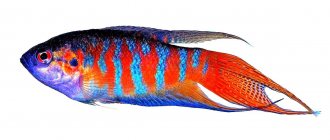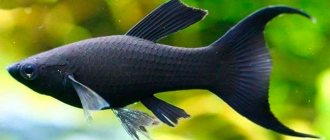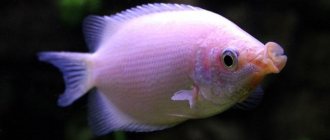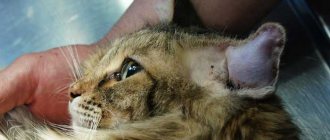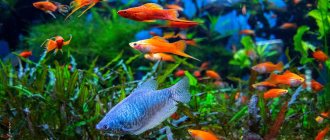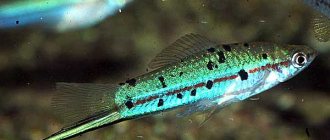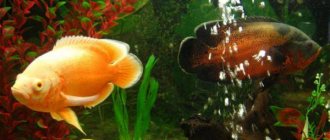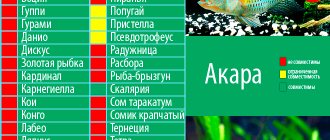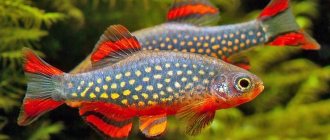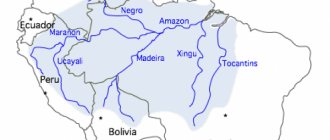Modern platies for aquariums are the result of the work of breeders. It was they who helped develop so many species of these fish and give them unusual colors. In nature, platies are larger and less noticeable. They live mainly in the lower reaches of rivers flowing into the Atlantic Ocean. The most beautiful species in their natural habitat were seen near Yucotan.
Common types of platies
Aquarists encounter different types of platies. In pet stores you can find breeds of different origins.
| Breed type | Name | Description |
| Natural | Spotted (Xiphophorus maculatus) | Golden scales, males up to 3.5 cm long, and females up to 5. |
| Multicolor (Xiphophorus variatus) | It has several color options and a rounded tail. Body length 5-6 cm. | |
| Steel body with inclusions. Montezuma's swordtail has an interesting elongated tail. | |
| Breeding | Pecilia radish | The caudal fin is black and resembles a brush, and the color of the body and head is most often bright red. |
| Flag | Large breed, with a body length of up to 7 cm. The dorsal fin is triangular. Body color can vary; individuals with a black body and yellow fins and outlines are more common. | |
| Black | It has iridescent scales and a peaceful disposition. It is often crossed with swordtails. | |
| Coral | A breed with an unusual blurred color in red-orange tones. | |
| Red | It has a fiery red body and translucent fins. | |
| Disk | It is distinguished by a rounded body shape. She needs to select peaceful and slow neighbors, since this fish is not particularly agile. There are different colors of this breed:
| |
| Blue (neon) | It is distinguished by its large body and bright blue body color with a silver belly. Grows up to 7 cm. | |
| White | As a result of selection, it was possible to breed an albino fish, whose internal organs can be seen through the transparent scales. It is noteworthy that this color is not transmitted at the genetic level. | |
| Mickey | It is distinguished by its yellow body, and its tail has spots similar to the outline of Mickey Mouse. | |
| Schwartz | A resinous stripe with a greenish tint runs along its body. |
In total, there are more than 130 breeding forms, among which there are options with unusual fins and tail.
Description
Platies are so diverse that it is difficult to give them a general description. The fish are peaceful and love to move around the aquarium in schools of 6-10 pieces. This makes them feel safe.
Many aquarists are interested in how long platies live in a home aquarium. But life expectancy depends directly on the characteristics of care. In nature it can live more than 7 years. In an aquarium, this period is reduced to 3-4 years.
Habitat in nature
Aquarists call platies mollies. Thanks to active selection, this type of fish has many colors and varieties. But in nature, fish are much more inconspicuous due to their modest and less bright body colors. South America is considered its homeland.
How to keep a platie
Do not put a small number of fish into the aquarium; there should be more than 6-8 of them (try to have 2-3 females for every 1 male). It is best to choose a spacious tank, since platies multiply very quickly. It is best to choose a capacity option from 40-50 liters.
It is better to set up an aquarium according to the following rules:
- Place a lid on top to prevent the fish from jumping out during active games.
- It is important for individuals to create coziness with the help of artificial lighting, for which you can use a regular table lamp with low power. The tank should receive natural light, but not direct sunlight.
- The interior of the aquarium must be equipped with shelters and plants. Walnut shells, driftwood, stones, and branches are suitable. Plant hornwort and elodea along the back and side walls. There should be room between them for the fish to move, but there should be a lot of plants. Leave the foreground free.
- Fill the bottom of the container with dark soil to make the fish look better.
- Install the filter and aerator.
Replace some of the water with fresh water weekly. If it is not hard enough, add marble chips to the soil.
Aquarists often add salt to the water for platies, as this disinfects it. Salt helps prevent disease, especially in young animals.
Motherland
The homeland of platies is America, where they live in the lower reaches of rivers flowing into the Atlantic Ocean. Under natural conditions, these schooling fish have a color ranging from yellowish-gray to spotted. It cannot be called very attractive, and today's bright fish are the result of the work of breeders.
Wild platies have a spotted color, which allows them not to stand out against the background of water and plants. Blue platies (pictured) will not go unnoticed!
Platies grow in nature up to 18 cm, and aquarium forms do not exceed 5 cm in length. Their body is shortened, resembling a diamond, with a fairly wide caudal fin. The head is proportional to the body, with large eyes. The mouth is directed upward. The movements of the fish are moderately fast, smooth, and not jerky.
To live in nature, fish choose places with dense thickets of aquatic plants, where they can hide from predators. The diet consists of algae and insects, as well as small aquatic invertebrates that do not have a strong shell.
These fish were brought to Europe late - only in the 20th century. They were brought from Mexico and Guatemala. The species was first described in 1886. In the USA, the species quickly attracted the attention of breeders, who, through their efforts, were able to obtain from a rather inconspicuous wild fish spectacular inhabitants for home ponds with colors ranging from red to blue, distinguished by their hardiness and even forgiving beginners many mistakes in caring for an aquarium. Platies are peaceful and can get along well with a large number of other fish species.
What and how to feed your platie
| Live food (at least occasionally) | Dry food (basic diet) | Top dressing |
| bloodworm; tubifex; coretra; daphnia; aulophorus. | daphnia; gammarus; ready-made industrial compositions (Tetra Min Rubin and Tetra Pro Colour). | spirulina flakes; cucumbers, zucchini; steamed semolina; washed bread crumb. |
It is best to give preference to live food, and give dry food less often. Plant foods are the least needed by platies, but you shouldn’t forget about them at all, since they are needed for the normal functioning of your pets’ gastrointestinal tract. If you do not give them plant food, they will begin to eat the green parts of plants.
Give food 1-2 times a day in such portions that they last for 5-7 minutes. If after this time there is food left on the water, remove it.
Fish breeding process
Platies are viviparous fish. They reach sexual maturity at 6-7 months of age. For spawning, they do not have to be placed in a separate tank; the process also works well in a general aquarium. The survival rate of the fry is good due to the fact that they develop inside the mother's abdomen.
If you place males and females together, then you will not have to interfere with the breeding process. In this case, all you have to do is control it, since platies are very prolific. A pregnant female is easily distinguished by its rounded abdomen and darkened scales around the anus.
During one spawning, she is capable of producing from 30 to 50 fry. If you do not control this process, then the addition of offspring will occur monthly.
After spawning, it is best to remove the adult female, otherwise she will destroy part of the offspring. Most aquarists prefer to place females in a separate aquarium during spawning, and then return them to the general one. The conditions of detention for individuals during breeding do not change. After birth, fry need to be fed up to 6-7 times a day with starter feed and live dust.
Content problems
There are usually no problems with keeping platies. If the purchased fish is sick, then the fish waste can be 100% already in the first week after purchase. This usually occurs with imported fish. If the fish is healthy and all conditions are met, then it will not cause much trouble. The fry can always be distributed to friends or given (albeit for free) to a bird or to stores.
Based on the results, we can say that the platyfish is a very unpretentious, bright fish, which is perfect for a novice aquarist. Maintain cleanliness in the aquarium, the feeding regime and norm, and the fish will delight your eyes for many years.
What fish and plants can be kept together?
In one aquarium you can place several species of platies or representatives of other peace-loving breeds:
- guppy;
- iris;
- catfish;
- rasboras;
- apistograms;
- swordtails;
- tetras;
- gourami;
- cardinals;
- zebrafish
They are incompatible with aggressive and large fish: carnivores, piranhas, cichlids. You should not house them with representatives of the carp family, as their temperature differs.
Compatibility
Platies are classified as “alkaline” fish, and this is important to take into account when choosing neighbors. You cannot add fish that require soft or acidic water to them. Platies optimally coexist with the following species:
- swordtails;
- mollies;
- guppy;
- various tetras;
- Ramiresi apistogram;
- zebrafish;
- catfish, including chain-mail catfish.
The following fish are unacceptable as neighbors:
- goldfish - due to the difference in size, they will perceive the platy fish as prey and swallow it;
- predatory fish;
- species that are not suitable for water parameters.
Based on this table, you can always wisely select neighbors for your pets.
Freshwater shrimp cannot be added to platies if they are small in size. When such inhabitants are large enough to be swallowed, they can also be combined with fish, which will look unusual and decorative.
In general, the compatibility of the species with its neighbors is quite high.
Probable diseases
With proper care, platies can live up to 5 years. The main enemy to their health is dirty and cold water. Common diseases of this type:
- Fin rot - with this disease, the fish develop red spots and gray sores on the body. The fins curl unnaturally and erosion occurs. Simple sanitary standards will help prevent the disease: regular filtration and aeration of water, replacing part of its volume.
- Ichthyophthiriasis is an immune disease that can be identified by the formation of a white coating on the fins. To treat individuals, they are immersed in salt baths and the drugs Bicillin 5 and Rivanol are used. Pathology appears due to the friction of the fish against the ground and stones.
- Fungal infections - with them, a white air coating, reminiscent of cotton wool, forms on the scales. Sick fish should be moved into a separate container, and the water in the general aquarium should be completely replaced.
Diseases rarely occur in platies; in most cases, they are caused by the neglect of their owners.
These Mexican fish can please the eye for a long time. Most of their species are active, so it is very interesting to watch them. If you are lucky, you will notice a unique property of platies - rebirth. Females of this species are capable of turning into males.
Diseases
Diseases are the result of improper care of the fish and the aquarium itself. It is important to do regular water changes, use various liquid products for preventive antiseptics and maintain a healthy internal environment.
Fin rot
With fin rot, the edges of the fins become covered with a white coating due to rare changes in water and infectious lesions. The pathology affects mainly young individuals and fry.
Ichthyophthiriasis or semolina
Small grains similar to semolina appear on the body. The infection can be acquired through contaminated food. In pet pharmacies you can buy medicines based on malachite green. She copes well with the disease.
Nematodes
Worm infestation of aquarium plants is not too dangerous for platies. These fish cope well with these parasites. It is recommended to regularly use products with antiseptic properties, which are added to aquarium water in a certain proportion.
